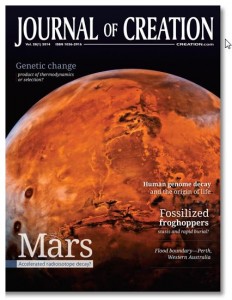
The latest issue of Journal of Creation is hot off the press again. I’ve had the privilege of seeing one of the first copies. Journal of Creation 28(1) April 2014 features Mars on its cover and has many excellent articles about biblical geology.
I like to feature this journal on this blog for a number of reasons. First, it alerts you to where you can get peer-reviewed information on biblical geology. Second, it shows that biblical geology is not a one-man, hobby-horse, but it is a broad movement being researched and developed by a network of qualified scientists around the world. Third, I want you to become informed and motivated so that you too will see the importance and potential of biblical geology and take steps to become better informed. And fourth, I would like people like you to subscribe to this journal so that the research grows and becomes strong.
Here is a sampling of the geology articles in the latest issue.
- Desert varnish grows much faster than geologists admitMeasurement based on lead from nearby smelters has turned the time beliefs about desert varnish on their head.
- Fossilized insect shows signs of stasis and rapid burialRemarkable implications from the discovery of finely preserved froghopper fossils.
- Precambrian rabbits—death knell for evolution?What type of evidence would it really take to falsify evolution?
- The meaning of the Great Unconformity and Sauk MegasequenceThese continental features can only be explained by large-scale, catastrophic processes.
- Tetrapods from fish?A review of Gaining Ground: The Origin and Evolution of Tetrapods by Jennifer A. Clack.
- Darwin’s dirty fossil secretA review of Darwin’s Doubt: The Explosive Origin of Animal Life and the Case for Intelligent Design by Stephen C. Meyer.
- Has Mars undergone one or more RATE episodes?The sudden heating of the crust due to accelerated decay would produce vast areas of hot subsurface magmas and surface volcanism.
- Perth area, Western Australia—Recessive stage of Flood began in the mid-Cretaceous and eroded kilometres of sediment from the continentFlood timing can be connected to regional geology using published geological cross sections and other geological data.
- Relating the Lava Creek Ash to the post-Flood boundaryTwo useful criteria to help determine the location of the Flood/post-Flood boundary for any specific area.
- Solar activity, cold European winters, and the Little Ice AgeCharge modulation of aerosol scavenging helps our understanding of the post-Flood Ice Age, and the ‘global warming’ issue.
There is a lot of really interesting reading in this issue, as there always is. It’s a journal for people who want a bit more meat, and to see what creation scientists are discussiong and debating. It’s excellent for academics and researchers. I find it amazing that the issues discussed here in Journal of Creation reappear in mainstream scientific journals a few years later. I think there are many people reading this journal who may not say so publically.